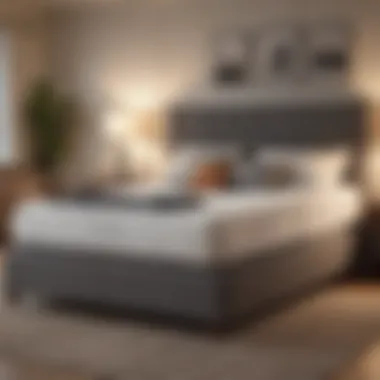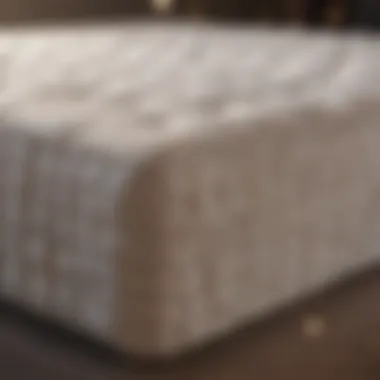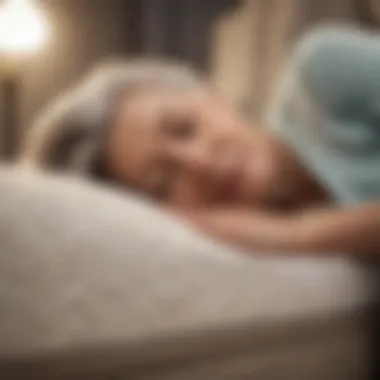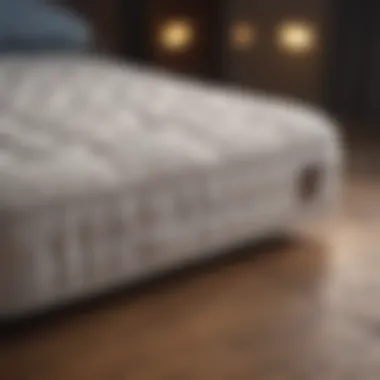Mattress Toppers for the Elderly: Enhance Sleep Quality


Intro
As people age, their bodies undergo various changes that can impact their sleep quality. Many elderly individuals experience discomfort or pain due to health conditions, which can be exacerbated by a lack of proper sleep support. This is where mattress toppers can play a crucial role. By adding a layer of cushioning and support, these products help enhance sleep quality. A well-chosen mattress topper can address specific needs such as pain relief, temperature regulation, and improved overall comfort.
In this guide, we will explore the multiple benefits that mattress toppers provide to the elderly, the various materials available, and how to choose the right one. Additionally, we will provide actionable insights and reviews of popular products on the market.
Key Takeaways
- Importance of Sleep: Quality sleep is essential for health, especially for seniors. Poor sleep can lead to cognitive decline and physical health issues.
- Benefits of Mattress Toppers: They can cushion pressure points, regulate temperature, and reduce motion transfer.
- Material Choices: Options include memory foam, latex, and gel-infused materials. Each offers unique advantages depending on the individual’s preferences.
- Product Reviews & Recommendations: Understanding specific brands and models can guide caregivers in making informed decisions.
- Considerations for Selection: Factors such as firmness, thickness, and personal health conditions should be considered when buying a mattress topper.
In-Depth Analysis
Understanding mattress toppers requires delving into several key aspects. The primary focus should be the material used in the toppers, as this impacts comfort, durability, and health benefits.
Material Types
- Memory Foam: Known for its ability to conform to the body’s shape, memory foam distributes weight evenly. This can help alleviate pressure points for those with joint pain.
- Latex: Natural or synthetic latex provides a supportive surface that maintains firmness. It is also resistant to dust mites and mold, making it a good option for those with allergies.
- Gel-Infused: This type of topper combines the pressure-relieving benefits of memory foam with cooling properties. It is beneficial for seniors who often experience night sweats.
Health Impacts
Scientific studies suggest that using a mattress topper can improve sleep quality. A study published in the Journal of Clinical Sleep Medicine found that individuals who used a memory foam mattress reported better sleep compared to those on traditional mattresses. Additionally, reducing back pain has often been associated with a supportive sleep surface, further aiding in restorative sleep.
“Proper sleep contributes to cognitive function and can enhance overall well-being, particularly in the elderly.”
Recommendations for Caregivers
When selecting a mattress topper for the elderly, consider these factors:
- Thickness: Thicker toppers generally provide more cushioning. A thickness of three to four inches is often recommended.
- Firmness: Depending on the individual's weight and any specific health concerns, choose a firmness that offers adequate support without sacrificing comfort.
- Price Point: While budget is a concern, investing in a good-quality topper can enhance sleep quality, making it a vital consideration.
Preamble to Mattress Toppers
Sleep is a crucial aspect of health, especially for the elderly. As people grow older, their sleep patterns often change, leading to sleep disturbances and decreased quality of rest. This is where mattress toppers can play a significant role. They are designed to enhance the comfort and support of an existing mattress, making sleep more restorative.
The Importance of Sleep for Seniors
For seniors, quality sleep contributes to overall well-being. Poor sleep can lead to a host of problems, including impaired cognitive function, mood disorders, and various health issues. According to studies, many older adults experience trouble falling asleep or staying asleep that can adversely impact their health. Thus, ensuring a comfortable sleeping environment is paramount. Good quality sleep helps with memory, emotional stability, and physical health, making it vital for seniors to address sleep problems effectively.
What is a Mattress Topper?
A mattress topper is an additional layer of cushioning applied atop an existing mattress. It serves multiple purposes, from altering the firmness level to enhancing pressure relief and comfort. Most toppers come in various materials, including memory foam, latex, gel, and more. This makes it possible to customize sleep surfaces.
The right mattress topper can significantly ameliorate sleep quality. It reduces the strain on joints, offers better body alignment, and can help with thermoregulation. By investing in a suitable mattress topper, caregivers and families can help seniors achieve more restful sleep. Understanding the features, benefits, and material options available is essential for making informed choices in improving sleep environments.
Benefits of Using Mattress Toppers for Elderly
Mattress toppers provide numerous advantages to elderly people. As individuals age, their sleep quality can suffer due to various factors, including health issues, joint pain, and changes in body composition. A mattress topper can significantly enhance sleep, making it a valuable investment for seniors and their caregivers. Understanding these benefits is crucial to choose the right product that caters to the specific needs of older adults.


Enhancing Sleep Quality
Quality of sleep is essential for overall health. For seniors, disruptions in sleep patterns can lead to various negative outcomes, including increased fatigue and decreased cognitive function. A mattress topper can enhance sleep quality by providing additional layers of comfort. By conforming to the body’s contours, these toppers reduce tossing and turning during the night. The right topper can lead to longer sleep periods and improved restfulness.
Pressure Relief
Pressure points often lead to discomfort for seniors, especially those with limited mobility. Using a mattress topper helps distribute body weight more evenly, effectively reducing pressure on sensitive areas such as the hips and shoulders. Memory foam and latex toppers are particularly effective in minimizing these pressure points. They allow for better blood circulation which can help in preventing sores and other issues related to prolonged pressure.
Temperature Regulation
Many seniors express concerns about temperature regulation while sleeping. Certain mattress materials can trap heat, leading to discomfort. Topper materials like gel-infused memory foam and breathable latex can help mitigate this issue by allowing for better airflow. This regulation keeps the sleeper cool during warmer months and comfortable in colder temperatures, significantly contributing to a more restful night.
Improving Joint Support
Joint pain is common among elderly individuals. Mattress toppers can provide extra support to joints, thus lessening discomfort. By selecting a topper with the right firmness level, caregivers can help provide the support elderly individuals need for their hips, knees, and back. This additional cushioning can lead to better alignment of the spine and joints, making a significant difference in the quality of sleep and daily functioning.
"Choosing the right mattress topper can profoundly affect senior health, affecting sleep quality and comfort levels."
Making informed choices about mattress toppers can lead to better sleep outcomes. By considering these benefits, families and caregivers can enhance the overall well-being of elderly individuals.
Types of Mattress Toppers
Understanding the various types of mattress toppers is crucial in making informed decisions about enhancing sleep quality for elderly individuals. Mattress toppers come in different materials, and each one has unique properties and benefits. Choosing the right type encompasses several factors, including comfort preferences, medical needs, and potential allergens. This section will delve into the prominent categories of mattress toppers commonly available in the market, highlighting the characteristics and advantages of each.
Memory Foam Toppers
Memory foam toppers are a popular choice among seniors. They are known for their outstanding ability to conform to the body shape, providing excellent support and comfort. The material is viscoelastic, meaning it reacts to pressure and temperature, allowing it to mold around the sleeper's body. This feature can greatly benefit elderly individuals who experience joint pain or discomfort due to pressure points.
- Pain Relief: Memory foam can help alleviate pain by distributing weight evenly, reducing pressure on specific body areas.
- Motion Isolation: This type also isolates movement, which can be particularly useful for couples, ensuring one person's movements do not disturb the other.
However, it is important to consider the density and thickness of memory foam toppers, as these factors affect their support and firmness levels.
Latex Toppers
Latex toppers are another viable option for seniors. These toppers can be made from natural or synthetic latex, each offering different properties. Natural latex is highly regarded for its eco-friendliness and durability.
- Supportive and Firm: They provide a firmer feel while still allowing some level of contouring, which can be beneficial for spinal alignment.
- Hypoallergenic: Latex is also less likely to harbor dust mites and allergens, making it a good choice for those with sensitivities.
One downside is that latex toppers can sometimes have a stronger smell, especially when new, due to the natural materials used.
Feather and Down Toppers
Feather and down toppers offer a luxurious sleeping experience. They are composed of soft materials, providing a cozy feeling. These toppers can be filled with either feathers or down clusters from ducks or geese.
- Softness: This type can add a plush layer of comfort to a firmer mattress, which some seniors may find soothing.
- Temperature Control: Feather and down have good breathability, helping to regulate temperature effectively.
However, individuals with allergies may need to avoid these types, as the materials can trigger reactions in sensitive individuals.


Gel Toppers
Gel toppers have gained popularity in recent years, especially those designed for the elderly. They combine foam with gel technology, which actively responds to the user’s body temperature and movements.
- Cooling Effect: This characteristic can help regulate body temperature, which is particularly useful for seniors who may experience overheating during the night.
- Pressure Relief: Gel toppers also provide solid pressure relief similar to memory foam but with added cooling benefits.
The responsiveness of these toppers makes them suitable for a variety of sleeping positions while maintaining comfort.
Hybrid Toppers
Hybrid toppers blend several materials, typically featuring layers of foam, gel, and sometimes latex or pocketed coils. This combination allows for a balance of comfort and support, making them versatile for various needs.
- Balanced Feel: They provide both softness and support, catering to those who prefer a mix of both methods.
- Customization: Many brands offer options to adjust layers, allowing caregivers to tailor the mattress to meet specific user needs.
Hybrid toppers can be a bit heavier due to the multiple layers, but they often deliver superior performance and adaptability for different sleeping styles.
Factors to Consider When Choosing a Mattress Topper
When selecting a mattress topper for elderly individuals, there are critical factors that caregivers and family members must consider. These elements significantly influence comfort, support, and safety, contributing to a better sleep experience. Understanding these aspects ensures that the chosen mattress topper effectively meets the unique needs of seniors.
Material Allergies
Material allergies are a primary concern when choosing a mattress topper. Many elderly individuals may have sensitivities to certain materials, which can lead to discomfort or adverse health effects. For example, common materials like latex can provoke allergic reactions in some people. Therefore, it is essential to review the composition of the topper before purchase. Options like memory foam or gel-infused materials can be suitable alternatives, as they usually cater to more wide-ranging sensitivities. Always check if the product is hypoallergenic, as this can help minimize the risk of allergic reactions.
Thickness and Density
The thickness and density of a mattress topper play a significant role in how it performs. A thicker topper can provide more cushioning, which can be beneficial for individuals with joint pain. On the other hand, a denser topper can offer more support, which may be necessary for proper spinal alignment. For seniors, a balance between thickness and density is vital. Choosing a topper that is too thick may make it challenging to get in and out of bed. Generally, a thickness of 2 to 4 inches is often recommended for the elderly, delivering the right mix of comfort and support.
Firmness Levels
Firmness levels are another critical factor when selecting a mattress topper. The ideal firmness depends on personal comfort preferences and specific health conditions. Some individuals may benefit from a firmer surface that provides more support, particularly those with back concerns. Conversely, others might prefer a softer feel for relief from pressure points. Many brands offer varying firmness options, allowing caregivers to adjust the choice according to the individual's needs. Test firmness levels when possible, ensuring that it meets the requirements of the sleeper.
Durability and Warranty
Durability and warranty are often overlooked but are crucial considerations. Seniors may require more frequent adjustments or replacements of their bedding. A durable mattress topper can withstand wear and tear, maintaining its shape and comfort over time. Checking for a warranty can provide peace of mind, as it ensures the product is a safe investment. Different manufacturers have different standards, so it’s advisable to research and select a topper that stands up to the rigors of everyday use, ideally with a warranty of a few years.
"A good mattress topper can enhance the comfort of a sleeping surface, significantly improving overall rest quality for elderly individuals."
In summary, by carefully evaluating material allergies, thickness and density, firmness levels, and durability with warranty, caregivers can make informed decisions. This diligence can significantly enhance sleep quality for elderly individuals, promoting better health and well-being.
Top Mattress Toppers for Seniors in the Market
Choosing the right mattress topper for seniors is critical to enhancing their sleep quality. As we age, our bodies require extra comfort and support. Mattress toppers act as an additional layer to help with this. They can significantly improve the sleep experience by providing better pressure relief, temperature regulation, and joint support. Given these factors, understanding what options are available on the market is essential, as it enables caregivers and families to make informed choices that benefit elderly individuals.
Product Comparisons
When it comes to product comparisons, one must consider a variety of factors including material, thickness, firmness, and price. Various brands offer different types of mattress toppers, and comparing their features is vital for making the best choice. Here are some categories to look at:


- Memory Foam Toppers: Known for contouring to the body and providing excellent support. Popular products like the Zinus Green Tea Memory Foam Mattress Topper offer a balance of comfort and support.
- Latex Toppers: These are considered more durable and provide a more bouncy feel compared to memory foam. Dunlopillo Latex Mattress Toppers are a great example.
- Feather and Down Toppers: These offer a plush, cushy feel. The Pacific Coast Feather Company products are well-known in this category.
- Gel Toppers: Gel-infused options, like those from Lucid, help with heat dispersion, making them suitable for those who sleep hot.
- Hybrid Toppers: Combining materials for diverse benefits, products from LUCID provide both support and comfort.
By comparing various products, users can identify which topper is suitable based on their unique needs and preferences.
User Reviews and Ratings
User reviews are an invaluable resource when evaluating mattress toppers. They provide insights about real-life usage, durability, and comfort. High ratings usually indicate customer satisfaction, which is important to consider. For example, many users of the Tempur-Pedic Mattress Topper rave about its support and feel, while others appreciate the breathable materials in the Saatva mattress toppers. On platforms like Reddit, discussions often highlight the pros and cons of different toppers, giving potential buyers a balanced perspective. It's advisable to look for consistently positive reviews and to highlight any recurring issues.
Price Ranges and Accessibility
Price can vary significantly based on the type of mattress topper. Generally, memory foam toppers can range anywhere from $100 to $300, depending on the brand and quality. Latex toppers often sit at a higher price point, sometimes exceeding $500. Feather and down options can also be pricey but offer unique benefits.
Accessibility is another point of consideration. Many seniors might prefer shopping online for convenience. Websites like Amazon provide a large selection alongside user reviews which can aid in decision-making. Local bedding stores often have promotions, making it potentially easier to see and feel products before purchasing. Here’s a brief guideline:
- Under $100: Basic options that might lack durability.
- $100 - $300: Mid-range toppers that usually balance quality and comfort.
- $300 - $500: Premium toppers with extensive features and longevity.
- Over $500: High-end options providing comprehensive support and longevity, typically for the user strongly prioritizing sleep quality.
Tips for Maintaining and Caring for Mattress Toppers
Caring for mattress toppers is essential, especially for the elderly. A well-maintained topper can prolong its life while contributing to better sleep quality. This section outlines practical and achievable strategies for cleaning and storing mattress toppers, ensuring they remain comfortable and effective for longer.
Cleaning Guidelines
Proper cleaning is vital for the hygiene and longevity of a mattress topper. Dust mites, allergens, and bacteria can accumulate over time, creating an unhealthy sleep environment. Here are some effective cleaning practices:
- Regular Vacuuming: Use a vacuum cleaner with an upholstery attachment to remove dust and debris. Regular vacuuming helps reduce allergens.
- Spot Cleaning: If spills occur, act quickly. Use a mild detergent mixed with water on a soft cloth to dab the stained area. Avoid soaking the topper and ensure it dries completely.
- Deep Cleaning: Depending on the material, deep cleaning may be necessary. Memory foam toppers can be cleaned with a solution of vinegar and water or specific cleaners made for foam. Always follow manufacturer instructions for optimal care.
- Protective Covers: Invest in a waterproof, breathable mattress protector. This shield against moisture while allowing airflow can enhance the lifespan of your topper.
Storage Considerations
When not in use, proper storage of a mattress topper is crucial. Incorrect storage can lead to damage or deformation. Here are some recommendations:
- Flat Storage: Ideally, store the topper flat. Avoid folding it, as creases can lead to lasting damage, especially for memory foam.
- Cool, Dry Environment: Choose a location that is cool and dry to prevent mold or mildew growth. Excessive heat or humidity can deteriorate the materials.
- Use a Storage Bag: If space is limited, use a breathable storage bag designed for mattress toppers. This bag will protect it against dust and pests without trapping moisture, keeping the material safe.
- Regular Checks: Periodically check the stored topper for signs of dampness, mold, or pests. Ensuring its condition can prevent unpleasant surprises when it’s time to use it again.
Remember: Regular maintenance and thoughtful storage don’t just enhance the lifespan of your mattress topper, they also contribute to better sleep, which is critical for senior health.
Finale
In this article, we explored the critical subject of mattress toppers for the elderly. It is essential to recognize the complex needs that arise with aging. Sleep quality is often compromised due to various factors such as health issues, pain, or discomfort. This is where mattress toppers can play a significant role. They provide the needed support and comfort, leading to enhanced sleep outcomes.
The benefits of using mattress toppers are notably profound, specifically designed to address the physical requirements of seniors. Choosing the right materials and types of toppers can mitigate pressure points, regulate body temperature, and ultimately promote deeper sleep. Awareness of specific materials, such as memory foam or latex, allows caregivers to select products that resonate well with individual needs.
Furthermore, practical considerations exist when selecting a mattress topper. Factors like durability, firmness, and allergy concerns are key aspects that should never be overlooked. Ensuring proper maintenance of these toppers contributes to their longevity and effectiveness, which is crucial for maximizing investment.
Finally, the insights discussed throughout this article can guide caregivers, family members, and health professionals in making informed decisions. By encouraging better sleep practices, we can significantly improve the overall well-being of the elderly, highlighting sleep's vital importance in sustaining health and quality of life.
Encouraging Better Sleep Practices
To promote better sleep for the elderly, it is critical to emphasize systematic practices that support restful nights. This begins with creating a conducive sleep environment. The bedroom should be quiet, dark, and at a comfortable temperature. Additionally, engaging in a consistent sleep schedule helps regulate the body's internal clock.
Moreover, practices such as limiting caffeine intake, particularly in the afternoon and evening, may also prove beneficial. Encouraging relaxation techniques like deep breathing, reading, or light stretching can also help transition into sleep more smoothly.
To further enhance sleep quality, consider the following:
- Assessing sleep environment: Ensure there is minimal noise and that the room is adequately darkened for optimal sleep conditions.
- Limiting screen time: Reducing the use of electronic devices before bedtime can promote better sleep onset.
- Consulting professionals: Engaging with health professionals about persistent sleeping issues can uncover underlying problems that require attention.
Adequate sleep is essential for overall health, particularly for seniors, who may face numerous health challenges. A focus on promoting healthy habits and making well-informed decisions about mattress toppers can lead to improved sleep experiences.







